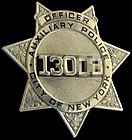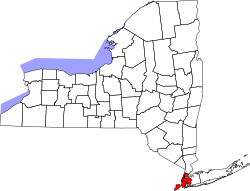New York City Police Department Auxiliary Police
| New York City Police Department Auxiliary Police | |
|---|---|
| Common name | NYPD Auxiliary |

Patch of the New York City Police Department Auxiliary Police
|
|

Flag of New York City
|
|

Shield of the New York City Police Department Auxiliary Police
|
|

Flag of the New York City Police Department
|
|
| Motto |
Fidelis ad Mortem Faithful till Death |
| Agency overview | |
| Formed | 1950 |
| Legal personality | Governmental: Government agency |
| Jurisdictional structure | |
| Operations jurisdiction* | City of New York in the state of New York, U.S. |
 |
|
| Map of New York City Police Department Auxiliary Police's jurisdiction. | |
| Size | 1,214.4 km² |
| Population | 8,274,527 |
| Legal jurisdiction | New York City |
| General nature |
|
| Operational structure | |
| Headquarters | Auxiliary Police Section 120-55 Queens Boulevard Kew Gardens, NY 11424 |
| Auxiliary Police Officers | 4,500+ |
| Police Commissioner responsible | James P. O'Neill |
| Agency executive | Inspector Phylis Bryne, Commanding Officer |
| Parent agency | New York City Police Department |
| Units |
List
|
| Boroughs |
List
|
| Facilities | |
| Commands |
76 Precincts 12 Transit Districts 9 Housing Police Service Areas |
| Police car/vans | 120 |
| Police boats | 2 |
| Website | |
| Official Site | |
| Footnotes | |
| * Divisional agency: Division of the country, over which the agency has usual operational jurisdiction. | |
76 Precincts
12 Transit Districts
The New York City Police Department Auxiliary Police is a volunteer reserve police force which is a subdivision of the Patrol Services Bureau of the New York City Police Department. Auxiliary Police Officers assist the NYPD with uniformed patrols, providing traffic control, crowd control, and other major events.
Over 4,500 Auxiliary Police officers contribute over one million hours of service each year. The NYPD Auxiliary Police program is the largest Auxiliary Police program in the United States.
There are seven titles (referred to as ranks) in the New York City Police Department Auxiliary Police:
The precursors to the Auxiliary Police were organized primarily during times of war when police officers were drafted into service, leaving the city with a diminished police force.
The Home Defense League was established in New York City in 1916 under Police Commissioner Arthur Woods to supplement the police force. Many police officers had joined the armed forces as the war in Europe progressed. Citizens volunteered to enroll in the Home Defense League to aid police in patrolling duties and be on hand in case of emergencies. In a matter of months, 22,000 people had volunteered for the Home Defense League. They were required to attend trainings on handling prisoners, protecting themselves, and using weapons. They received no pay. If the need arose (as it did in 1917 when armed forces were mobilized), they could be called into service to guard armories, subway stations, and other areas of the city.
In 1918, the Home Defense League changed its name to the New York Reserve Police Force, as proposed by Commissioner Richard Enright, in addition to undergoing higher-caliber training under Special Deputy Police Commissioner Lewis Rodman Wanamaker. Over 3,000 women joined the Police Reserve, serving under Captain Mary Noonan, primarily to provide eyes and ears for the police, look out for children's safety, and give first aid if necessary. Governor Alfred E. Smith signed a new state law in 1920 that established the permanency of a reserve force as an adjunct of the police department. By the mid-1920s, however, the Police Reserve had gradually stopped functioning as an active part of the Police Department, due to political disputes in a high-crime period. The Reserve was formally disbanded in 1934.
...
Wikipedia
